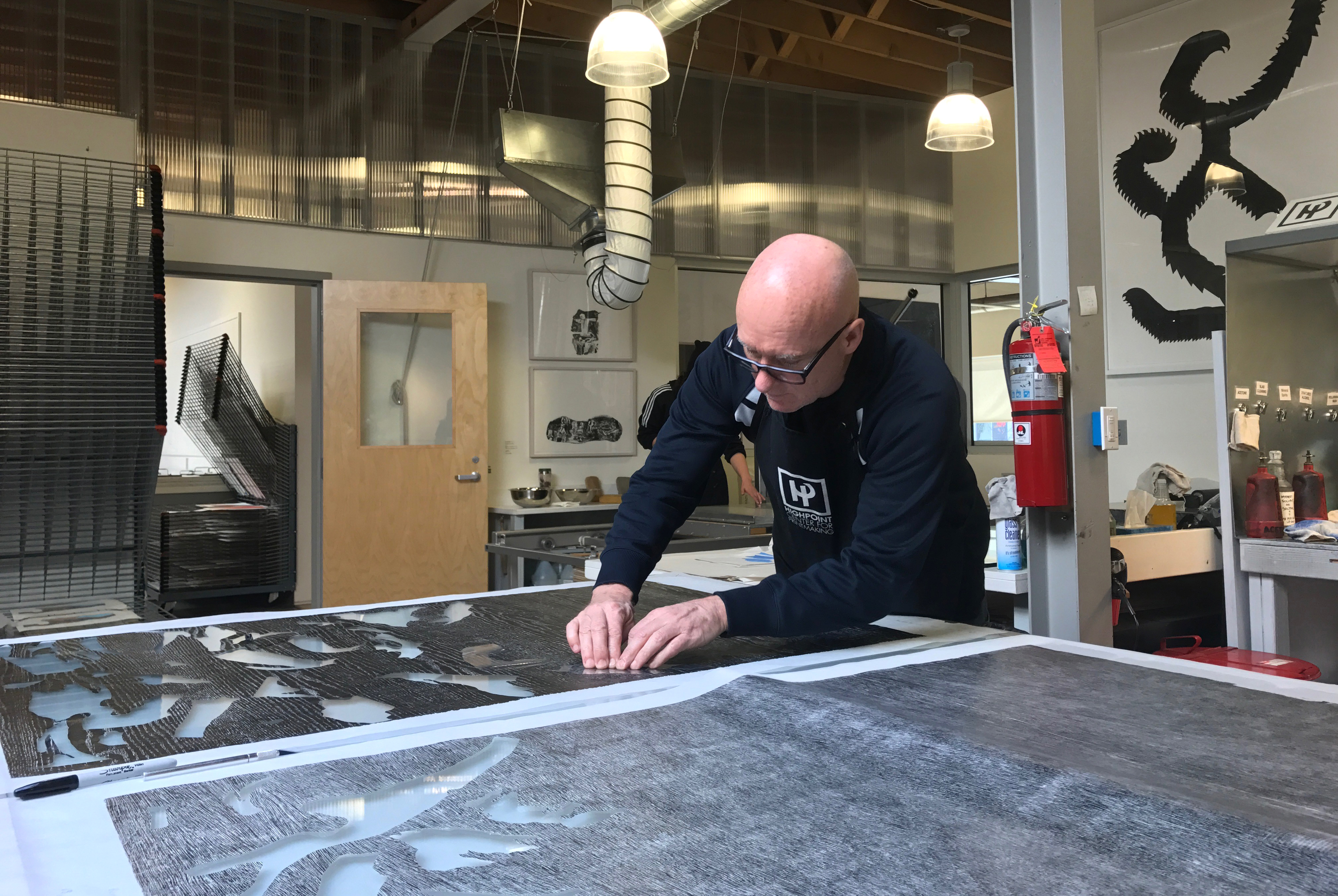
Born 1957, Spokane, Washington
Jim Hodges makes use of common, everyday objects to investigate issues of intimacy, memory, and loss. His first one-person gallery show, in 1994, included 565 paper napkins pinned to the wall. Each bore a ballpoint-pen flower that the artist drew while sitting alone in a coffee shop. Other works are constructed of filmy headscarves, faded jeans, mirror fragments, and fake flowers. The thrill for viewers, wrote the art critic Dorothy Spears, is seeing familiar things “elegiacally transformed”1 into spectacles of beauty. Hodges is drawn not just to the poetic potential of commonplace materials but also to craft. In the 1990s, he began taking apart artificial flowers and stitching the pieces into massive curtains . They were profoundly expressive yet wrought from “a language otherwise associated with cheap sentimentality.”2 In 2013, Hodges disassembled secondhand jeans to make a wall-size tapestry approximating a roiling sky he’d seen in upstate New York. Like other works, it carries personal meaning: Hodges’s mother used to patch his jackets with his old jeans.

Hodges grew up in a Roman Catholic family in Spokane, Washington, where his father worked in sales and his mother raised their six children. Hodges got his BFA from nearby Fort Wright College (1980), then moved to New York in 1983 to attend Pratt Institute, earning an MFA in painting (1986). After graduation, finding himself dissatisfied with contemporary discussions about painting, he focused on found objects and drawing. In exchange for studio space, he worked part-time as an art handler for the New York collector Elaine Dannheisser. This was also when the AIDS crisis was intensifying. The catalogue for the retrospective “Jim Hodges: Give More Than You Take” (2013–15), organized by the Dallas Museum of Art and the Walker Art Center, Minneapolis, notes that in the tumultuous 1990s, Hodges pioneered “a new visual language of generosity and restraint.”3 His flower motif suggests the fragility of life, mourning, beauty—and love, which curator Jonas Storsve says is ubiquitous in his work.4 Hodges’s for Highpoint Editions attests to a childhood spent in the woods. Using novel and complex techniques, he presented each of the four seasons in transition. In Finally (2017) (cat. no. 161) , which signifies spring, a screenprint of flowers and butterflies is glimpsed through hand-cut openings in the upper sheet. Bringing in the Ghosts (2019) (cat. no. 162) , representing autumn, features a sixty-two-color lithograph modeled after camouflage (another Hodges motif ) and cut into strips. Intense fall sun is conveyed through a bottom layer of brushed foil, visible between the strips, and glowing dots strung along the surface.
Hodges’s eclectic work, ranging from disco balls to billboards , has been exhibited worldwide for the past twenty years. Along with group shows, he has had solo shows at the Contemporary Austin, Texas (2016); Aspen Art Museum, Colorado (2014, 2009); Centre Pompidou, Paris (2009–10); Centro Galego de Arte Contemporánea, Santiago de Compostela, Spain (2005); Hirshhorn Museum and Sculpture Garden, Washington, D.C. (2005); Museum of Contemporary Art, Cleveland (2004); Skidmore College’s Tang facility, Saratoga Springs, New York (2003–5); and other locations. Hodges is based in New York.
—Marla J. Kinney
Notes
Dorothy Spears, “A Career of Engagement,” New York Times, October 27, 2013, New York edition, section F, p. 24, https://www.nytimes.com/2013/10/27/arts/artsspecial/for-jim-hodges-a-survey-of-a-career-reflecting-on-life.html. ↩︎
Allan Schwartzman, “Parts and All,” in Jim Hodges (exh. cat.), by Ian Berry and Ron Platt, Tang Teaching Museum and Art Gallery, Skidmore College (Saratoga Springs, N.Y., 2003), p. 79. ↩︎
Jeffrey Grove and Olga Viso, eds., Jim Hodges: Give More Than You Take (exh. cat.), Dallas Museum of Art and Walker Art Center (Minneapolis, 2013), p. 8. ↩︎
Jonas Storsve, “Who’s Afraid of Beauty” (trans. Gila Walker), in Jim Hodges: Love et cetera (exh. cat.), Centre Pompidou, Paris, 2009, p. 15. ↩︎